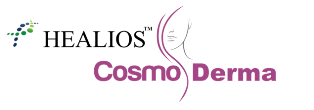What is seborrhoeic dermatitis?
Seborrhoeic dermatitis (American spelling is ‘seborrheic’) is a common, chronic or relapsing form of eczema/dermatitis that mainly affects the sebaceous, gland-rich regions of the scalp, face, and trunk .
There are infantile and adult forms of seborrhoeic dermatitis. It is sometimes associated with psoriasis (sebopsoriasis). Seborrhoeicdermatitis is also known as seborrhoeic eczema.
Dandruff (also called ‘pityriasis capitis’) is an uninflamed form of seborrhoeic dermatitis. Dandruff presents as bran-like scaly patches scattered within hair-bearing areas of the scalp.
What causes seborrhoeic dermatitis?
The cause of seborrhoeic dermatitis is not completely understood. It is associated with proliferation of various species of the skin commensal Malassezia, in its yeast (non-pathogenic) form. Its metabolites (such as the fatty acids oleic acid, malssezin, and indole-3-carbaldehyde) may cause an inflammatory reaction. Differences in skin barrier lipid content and function may account for individual presentations.
Who gets seborrhoeic dermatitis?
Infantile seborrhoeic dermatitis affects babies under the age of 3 months and usually resolves by 6–12 months of age.
Adult seborrhoeic dermatitis tends to begin in late adolescence. Prevalence is greatest in young adults and in the elderly. It is more common in males than in females.
The following factors are sometimes associated with severe adult seborrhoeic dermatitis:
- Oily skin (seborrhoea)
- Familial tendency to seborrhoeic dermatitis or a family history of psoriasis
- Immunosuppression: organ transplant recipient, human immunodeficiency virus (HIV) infection and patients with lymphoma
- Neurological and psychiatric diseases: Parkinson disease, tardive dyskinesia, depression, epilepsy, facial nerve palsy, spinal cord injury and congenital disorders such as Down syndrome
- Treatment for psoriasis with psoralen and ultraviolet A (PUVA) therapy
- Lack of sleep, and stressful events.
What are the clinical features of seborrhoeic dermatitis?
Infantile seborrhoeic dermatitis
Infantile seborrhoeic dermatitis causes cradle cap (diffuse, greasy scaling on scalp). The rash may spread to affect armpit and groin folds (a type of napkin dermatitis).
- There are salmon-pink patches that may flake or peel.
- It is not especially itchy, so the baby often appears undisturbed by the rash, even when generalised.
Adult seborrhoeic dermatitis
Seborrhoeic dermatitis affects scalp, face (creases around the nose, behind ears, within eyebrows) and upper trunk.
Typical features include:
- Winter flares, improving in summer following sun exposure
- Minimal itch most of the time
- Combination oily and dry mid-facial skin
- Ill-defined localised scaly patches or diffuse scale in the scalp
- Blepharitis: scaly red eyelid margins
- Salmon-pink, thin, scaly, and ill-defined plaques in skin folds on both sides of the face
- Petal or ring-shaped flaky patches on hair-line and on anterior chest
- Rash in armpits, under the breasts, in the groin folds and genital creases
- Superficial folliculitis (inflamed hair follicles) on cheeks and upper trunk
Extensive seborrhoeic dermatitis affecting scalp, neck and trunk is sometimes called pityriasiform seborrhoeide.
How is seborrhoeic dermatitis diagnosed?
Seborrhoeic dermatitis is diagnosed by its clinical appearance and behaviour. As malassezia are a normal component of skin flora, their presence on microscopy of skin scrapings is not diagnostic.
Skin biopsy may be helpful but is rarely indicated. Histological findings specific to seborrhoeic dermatitis are superficial perivascularand perifollicular inflammatory infiltrates, psoriasiform hyperplasia, and parakeratosis around follicular openings.
What is the treatment for seborrhoeic dermatitis?
Treatment of seborrhoeic dermatitis often involves several of the following options.
- Keratolytics can be used to remove scale when necessary, eg salicylic acid, lactic acid, urea, propylene glycol
- Topical antifungal agents are applied to reduce malassezia eg ketoconazole, or ciclopirox shampoo or and/or cream. Note, some strains of malassezia are resistant to azole antifungals. Try zinc pyrithione or selenium sulphide
- Mild topical corticosteroids are prescribed for 1–3 weeks to reduce the inflammation of an acute flare
- Topical calcineurin inhibitors (pimecrolimus cream, tacrolimus ointment) are indicated if topical corticosteroids are often needed, as they have fewer adverse effects on facial skin.
In resistant cases in adults, oral itraconazole, tetracycline antibiotics or phototherapy may be recommended. Low dose oral isotretinoinhas also been shown to be effective for severe or moderate seborrhoeic dermatitis.
Scalp treatment
- Medicated shampoos containing ketoconazole, ciclopirox, selenium sulfide, zinc pyrithione, coal tar, and salicylic acid, used twice weekly for at least a month and if necessary, indefinitely.
- Steroid scalp applications reduce itching, and should be applied daily for a few days every so often.
- Calcineurin inhibitors such as tacrolimus can be used as steroid alternatives.
- Coal tar cream can be applied to scaling areas and removed several hours later by shampooing.
- Combination therapy is often advisable.
Face, ears, chest and back
- Cleanse the affected skin thoroughly once or twice each day using a non-soap cleanser.
- Apply ketoconazole or ciclopirox cream once daily for 2 to 4 weeks, repeated as necessary.
- Hydrocortisone cream can also be used, applied up to twice daily for 1 or 2 weeks. Occasionally a more potent topical steroid may be prescribed.
- Topical calcineurin inhibitors such as pimecrolimus cream or tacrolimus ointment may be used instead of topical steroids.
- A variety of herbal remedies are commonly used, but their efficacy is uncertain.
Management in infants
Regular washing of the scalp with baby shampoo or aqueous cream is followed by gentle brushing to clear the scales.
- White petrolatum may be useful.
- Topical antifungals are often prescribed, depending on the extent of the rash.

 7975288129 / 7483528607
7975288129 / 7483528607
